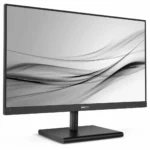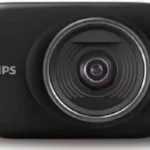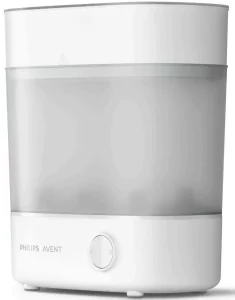
PHILIPS SCF291 Avent Sterilizer User Manual
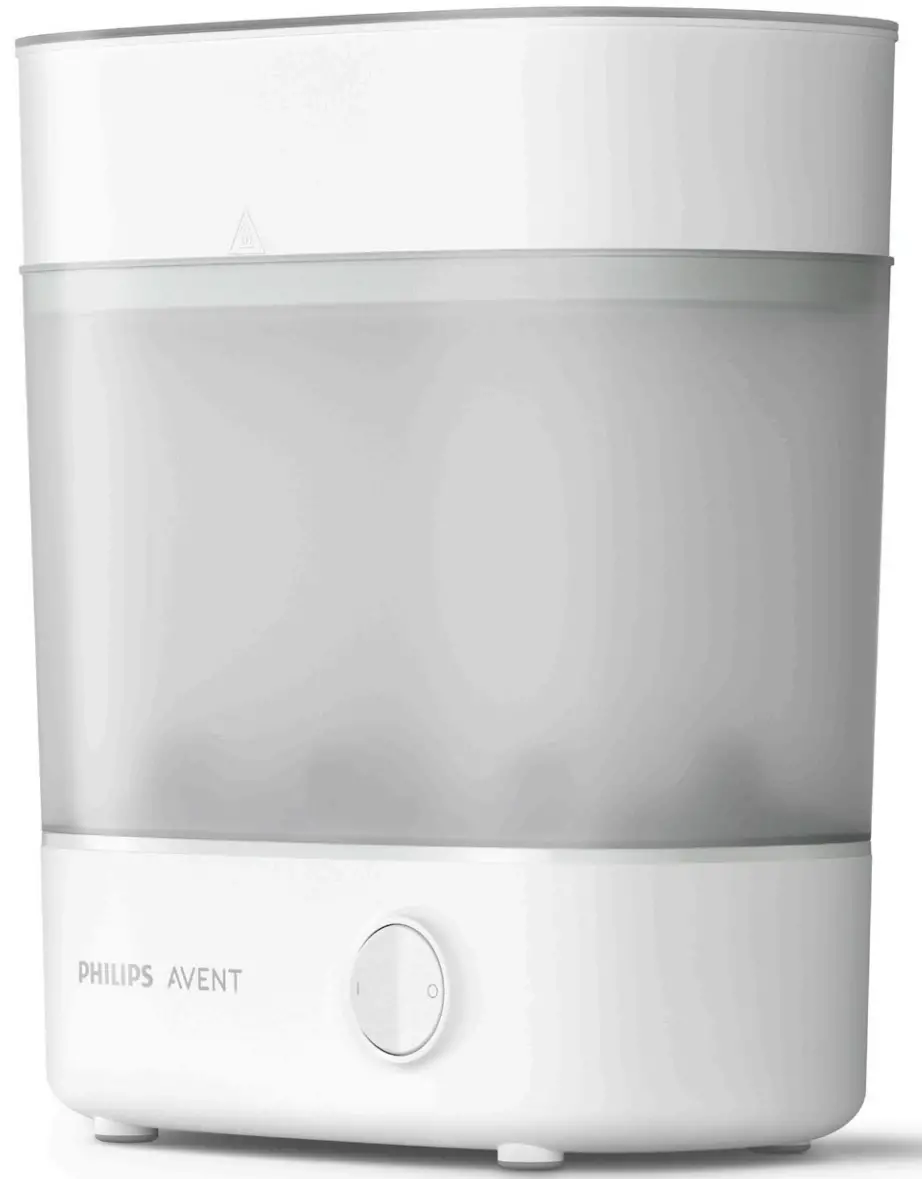
IMPORTANT SAFEGUARDS
When using electrical appliances, basic safety precautions should always be followed including the following:
- Read all instructions.
- To protect against electrical shock do not immerse cord, plugs or appliance in water or other liquid.
- Close supervision is necessary when any appliance is used by or near children.
- Always unplug from outlet when not in use and before cleaning. Allow to cool before putting on or taking off parts.
- Always unplug the cord of the sterilizer before pouring away water and/or rinsing.
- Do not operate any appliance with a damaged cord or plug or after the appliance malfunctions or has been damaged in any manner.
- The use of accessory attachments not recommended by the appliance manufacturer may cause injuries.
- Do not use outdoors.
- Do not let cord hang over edge of table or counter, or touch hot surfaces.
- Do not place on or near a hot gas or electric burner, or in a heated oven.
- Extreme caution must be used when moving an appliance containing hot liquids.
Always let the appliance cool down before moving, cleaning or storing it. - Always unplug the appliance when not in use.
- Do not use appliance for other than intended use.
- WHEN IN USE, THE STERILIZER CONTAINS BOILING WATER AND STEAM ESCAPES FROM THE VENT IN THE LID.
- Ensure the sterilizer is placed on a firm level surface when in use.
- Never move or open the unit when in use.
- Always keep out of reach of children.
- Never place items on top of the sterilizer.
- To stop the sterilizer during the cycle, unplug at the electrical outlet.
- Take care when opening as steam can burn.
- Do not use chemical sterilizing solutions/tablets or bleach in your steam sterilizer or on products to be sterilized.
- Do not use abrasive, antibacterial materials or scourers to clean the sterilizer.
- Do not use softened water in the sterilizer.
- A short power cord has been provided to prevent the risk of it becoming entangled in or being tripped over. Extension cords may be used if care is exercised in their use.
- If an extension cord is used, its electrical rating must be as great as the rating of the appliance and it must not be draped over the edge of the table top where it could be pulled by children or tripped over. The extension cord should be a grounded type 3 wire cord.
- Failure to follow de-scaling instructions may cause irreparable damage.
- There are no serviceable parts inside the sterilizer. Do not attempt to open, service or repair the sterilizer yourself.
- Do not touch hot surfaces. Use handles or knobs.
- HOUSEHOLD USE ONLY.
- Check if the voltage that is indicated on the appliance corresponds to the local voltage before you connect the appliance.
- Never turn on the sterilizer before filling water into the water reservoir in Sterilize and Auto mode.
- Do not sterilize very small parts which can fall through the holes of the containers
- Using homeopathic additives in water can have negative impact on steam, health and can damage plastic parts.
SAVE THESE INSTRUCTIONS
Caution
- Never use any accessories or parts from other manufacturers or Philips which are not specifically recommended. If you use such accessories or parts, your warranty becomes invalid.
- Use distilled water without any additives.
- Do not put bleach or other chemicals in the appliance.
- Only sterilize baby feeding products that have been approved for sterilization.
- Do not expose the appliance to extreme heat or direct sunlight.
- Environmental conditions can influence the function of the appliance e.g. temperature, air pressure, local altitudes (sea level), etc.
Introduction
Congratulations on your purchase and welcome to Philips Avent! To fully benefit from the support that Philips Avent offers, register your product at www.philips.com/welcome.
General description

- A Lid with grip
- B Small basket
- C Bottom plate for large basket
- D Large basket with drip tray
- E Maximum water level indicator
- F Heating element with water reservoir
- G Base unit
- H Power cord
- I Tongs
- J Cord storage
- K Indicator light
- L Power on button
- M Power off button
Things to Note
- Don’t immerse the base unit in water.

- Use 130 ml/4.5 oz water.

- Clean items to be sterilized before putting them into the sterilizer.

- Disassemble all bottle parts completely and place them in sterilizer with openings pointing down to prevent from filling up with water.

- Pour out the remaining water from large basket after each use.

- Descale the sterilizer every 4 weeks.
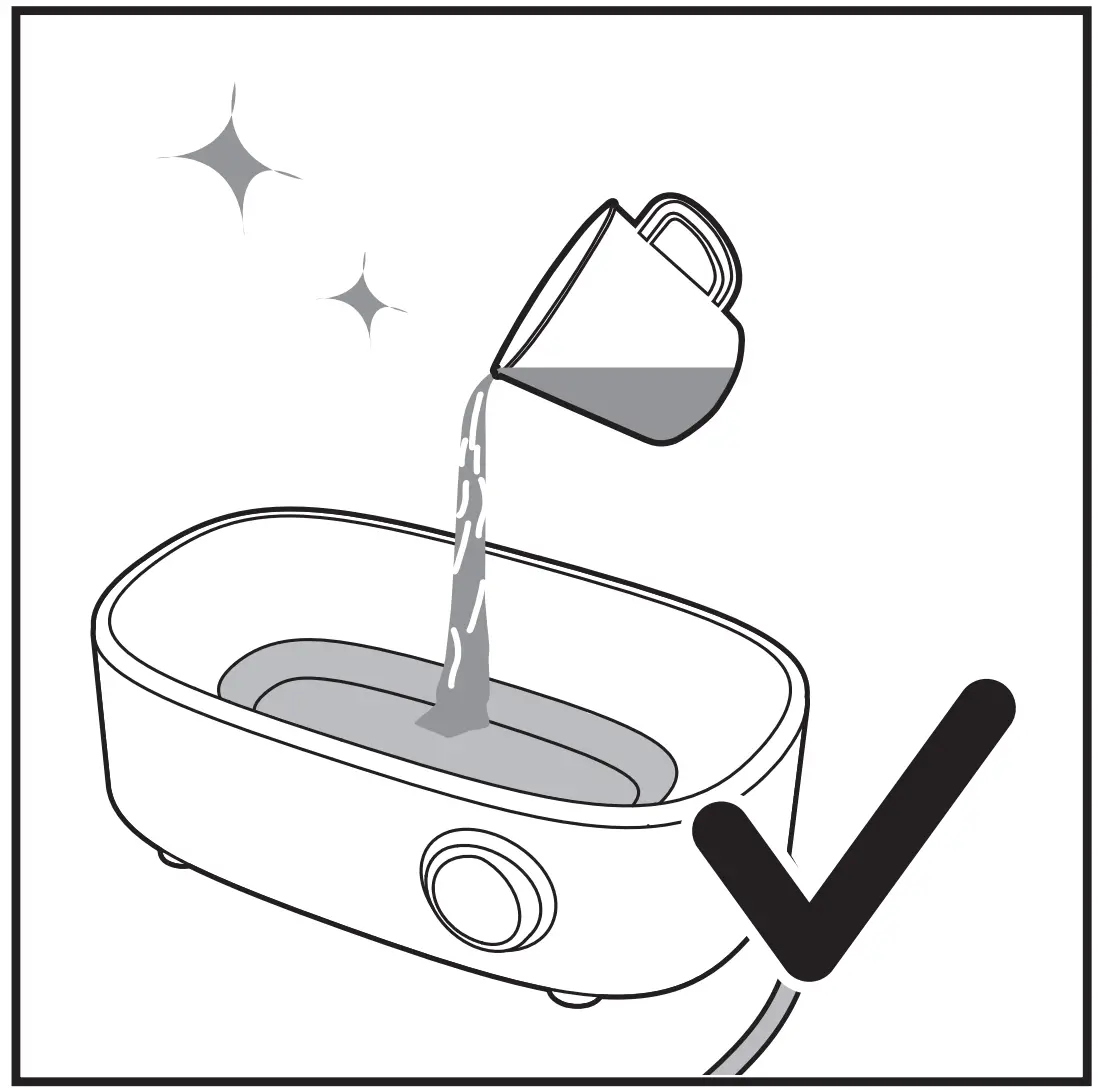
Getting to know the settings
Note: Before you sterilize bottles and other items, clean them first. Only place items in the sterilizer which are suitable for sterilizing. Do not sterilize items that are filled with liquid, e.g. a teether with cooling fluid.
Sterilize

- Sterilize mode is for sterilizing baby items.
- A sterilizing cycle takes approximately 10 minutes.
- Heating up takes approximately 4 minutes and sterilizing takes approximately 6 minutes.
- Make sure to pour exactly 130 ml/4.5 oz water directly into the water reservoir of the base .
Before first use
When you use the appliance for the first time, we advise you to let it complete one sterilization process with empty baskets.
- Use a clean baby bottle and pour exactly 130 ml/4.5 oz water directly into the water reservoir of the base.
Tip: This appliance has been designed to be used with tap water. In case you live in an area with hard water, fast scale build-up may occur. Therefore, it is recommended to use water without minerals such as distilled or purified water to prolong the lifetime of your appliance. For more information on limescale, see section “Descaling”.

- Place the large basket on the base.

- Place the bottom plate in the large basket.

- Place the small basket on the large basket.

- Place the lid on top of the small basket.

- Put the plug in the wall socket.

- Press the power on button to switch on the appliance.

Note: If you plug in the appliance after you have pressed the power on button, the sterilizer starts working immediately.
You can switch it off by pressing the power off button.
Caution: The base, the baskets and the lid become hot during or shortly after operation.- The on/off indicator light lights up to indicate that the appliance starts sterilizing.
- When the sterilization process is finished, the light goes off and the appliance switches off automatically.
- After the appliance has cooled down completely, remove the lid, the small basket, the bottom plate, the large basket and wipe them dry.
Note: When you remove the large basket from the base, be aware of the remaining water on the base drip tray. - Let the appliance cool down completely for approximately 10 minutes before you use it again.
Note: The appliance does not work for 10 minutes after a sterilizing cycle. It needs to cool down first.
Preparing for use
Preparing for sterilizing
Before you put the items to be sterilized in the sterilizer, clean them thoroughly in the dishwasher or clean them by hand with hot water and liquid dishwashing detergent.
Assembling the sterilizer
There are several ways to assemble the sterilizer.
- With only the small basket on the base to sterilize small items such as soothers.

- With only the large basket on the base to sterilize medium-sized items such as breast pump parts, toddler plates or toddler cutlery.

- With the large basket and the small basket on the base to sterilize up to six 330ml/ 11oz bottles. Place the bottles upside down in the large basket and place the bottle dome caps, screw rings and nipples in the small basket.

Note: When you fill the small basket, put screw rings on the bottom, place the nipples and the bottle caps loosely on top of the screw rings.

Note: Make sure all parts that need to be sterilized are completely disassembled and place them in the basket with their openings pointing down to prevent them from filling up with water.
Using the appliance
Sterilizing
The sterilizer’s thorough and chemical-free cleaning will keep its contents sterile for up to 24 hours with the lid on. After sterilization, the water left on the baby items is sterile and will not collect germs.
- Pour water directly into the water reservoir of the base (see section “Before first use”).
- Assemble the sterilizer (see section “Assembling the sterilizer”) and place the items to be sterilized in it.
- Place the lid on top of the small or large basket.

- Put the plug in the wall socket.

- Press the power on button to switch on the appliance.

Caution: The base, the baskets and the lid become hot during or shortly after operation.
Note: You can switch the appliance off by pressing the power off button.- The on/off indicator light lights up to indicate that the appliance starts sterilizing.
- When the sterilization process is finished, the light goes off and the appliance switches off automatically.
- Remove the lid.
Wait until the appliance has cooled down before you remove the lid.
Be careful. Hot steam may come out of the sterilizer. - Remove the bottles and other items from the basket. Use the tongs to remove the smaller items.
Be careful. The sterilized items may still be hot.
Note: Make sure you wash your hands thoroughly before you touch the sterilized items. - Unplug the appliance and wait until the appliance has cooled down completely.
- Remove the small basket and large basket.
Note: When you remove the large basket, be aware of the remaining water on the base drip tray.
Note: The drip tray is designed to catch milk or food residue and prevent it from going into the water reservoir of the base. This is to optimize the sterilizing performance and make the heating element easy to clean. - Detach the bottom plate from the large basket. Pour out any remaining water from the large basket drip tray and clean it (see section “Cleaning”).
- Pour out any remaining water from the water reservoir and wipe it dry.
Note: The appliance does not work for 10 minutes after a sterilizing cycle. It needs to cool down first.
Cleaning
Do not use abrasive or aggressive cleaning agents (e.g. bleach) or a scouring pad to clean this appliance.
Never immerse the base and the power cord in water or any other liquid.
Note: The sterilizer is not dishwasher-proof. The baskets, the bottom plate and the lid can be cleaned with hot water and liquid dishwashing detergent.
- Always unplug the appliance and let it cool down before you clean it.
- Clean the base with a moist cloth.
- Detach the bottom plate from the large basket.
Pour out any remaining water from the large basket drip tray.
Note: Water accumulates on the large basket drip tray after each sterilizing cycle.
Pour out the remaining water from the large basket after each use.

- Clean the lid, the small basket, the bottom plate and the large basket in hot water with some liquid dishwashing detergent.
Note: After cleaning, store the sterilizer in a clean and dry place.
Descaling
The sterilization process is extremely important to ensure the most hygienic standards for your baby. Limescale deposits can slow down the sterilization cycle and even impair its effectiveness.
Limescale is the hard and chalky deposit. Depending on the water type in your area, limescale can have different appearances ranging from snow white looking powder to brownish stains. The harder the water, the faster scale builds up. It builds up in appliances as the residue of minerals naturally contained in water, which fail to evaporate when water is heated. Although it is not harmful as such, it is unsightly, hard to clean and can impair the operation of appliances or damage their components if allowed to build up.
Descale the sterilizer at least every 4 weeks to ensure it works efficiently.
- Pour 90 ml/3 oz of white vinegar (5% acetic acid) and 30 ml/1 oz of water into the water reservoir.

- Place the small basket on the base. Place the lid on top of the small basket.

- Press the power on button to switch on the appliance.

Note: Place the small basket on the base to prevent hot liquid from splashing out. - Let the appliance operate for 5 minutes, and then press the power off button to switch it off.

- Empty the water reservoir and rinse it thoroughly. If you still see traces of scale, remove it by sponge. Rinse again and wipe the base with a damp cloth.
- Rinse the small basket and lid as well to remove vinegar solution.
Note: You can also use citric acid based descalers.
Note: Do not use other types of descalers.
Ordering accessories
To buy accessories or spare parts, visit www.philips.com or go to your Philips dealer. You can also contact the Philips Consumer Care Center in your country (see the worldwide guarantee leaflet for contact details).
Disposal
Your product is designed and manufactured with high quality materials and components, which can be recycled and reused. For recycling information, please contact your local waste management facilities or visit www.recycle.philips.com.
Assistance
For assistance visit our website: www.philips.com/Avent or call 1-800-54-Avent (1-800-542-8368).
Warranty
FULL TWO-YEAR WARRANTY
Philips North America LLC (USA) and Philips Electronics Ltd (CANADA) warrant each new Philips Avent product, model SCF291, against defects in materials or workmanship for a period of two years from the date of purchase, and agree to repair or replace any defective product without charge.
IMPORTANT: This warranty does not cover damage resulting from accident, misuse or abuse, lack of reasonable care, or the affixing of any attachment not provided with the product.
NO RESPONSIBILITY IS ASSUMED FOR ANY SPECIAL, INCIDENTAL OR CONSEQUENTIAL DAMAGES.
In order to obtain warranty service, simply call 1-800-54 Avent.
Note: This appliance needs to be descaled regularly for optimal performance. If you do not do this, the appliance may eventually stop working. In this case, repair is NOT covered by your warranty.
Manufactured for:
Philips Personal Health
A division of Philips North America LLC
P.O. Box 10313, Stamford, CT 06904, USA
In Canada imported by: Philips Electronics Ltd
281 Hillmount Road, Markham, ON L6C 2S3
Troubleshooting
This chapter summarizes the most common problems you could encounter with the appliance. If you are unable to resolve the problem with the information below, contact the Consumer Care Center in your country.
| Problem | Solution |
| When should I descale my sterilizer? | When you use the sterilizer, you may notice that there are small spots ranging from snow white to brownish appearing on the heating plate. This is a sign that your sterilizer should be descaled. In any case, the sterilizer should be descaled at least every 4 weeks to ensure that it continues to work effectively. |
| Why is the sterilizing time so short? | You did not add enough water for sterilizing. Pour exactly 130 ml/4.5 oz water directly into the water reservoir of the base. |
| Why is there still much water remaining on the heating plate after sterilizing? | The heating plate may be blocked by the limescale. The sterilizer should be descaled at least every 4 weeks. See section “Descaling”. |
| Why is there a burning smell and burnt mark on the base? | You may not have poured out the remaining water from the large basket drip tray regularly. Water accumulates on the large basket drip tray after each sterilizing cycle. Pour out any remaining water from the large basket after each use.
The items may not have been cleaned thoroughly before sterilizing. Before you put the items to be sterilized in the sterilizer, clean them thoroughly in the dishwasher or by hand with hot water and liquid dishwashing detergent. |
| Coating is peeling off from the heating plate. Does it affect the function? | It does not affect the function of the sterilizer. Make sure you do not use any abrasive or aggressive cleaning agents (e.g. bleach) or a scouring pad to clean the heating plate. |
| Why does the sterilizer stop working? | The heating plate may be blocked by the limescale. The sterilizer should be descaled at least every 4 weeks. See section “Descaling”. |
| Do I need to dry baby items after sterilizing? | The sterilizer’s thorough, chemical-free cleaning will keep its contents sterile for up to 24 hours if keeping the lid on. Water left on baby items after sterilization is sterile and would not collect germs, so you do not need to dry. |

© 2022 Koninklijke Philips N.V.
All rights reserved.
03/02/2022
